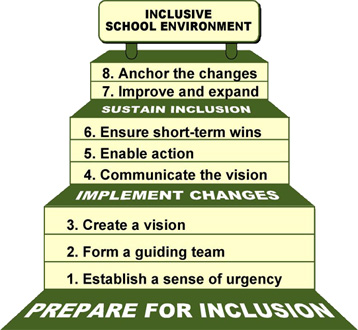What model can school leaders use to guide the change necessary for creating inclusive school environments?
Page 4: Kotter’s Model of Change
The real challenge … is changing old assumptions and practices to reinvent schools rather than simply making additions or corrections to existing practice.
Although legislation and professional standards outline the what and how of educating all students, uncertainty over the exact nature of the steps to implementing change can make achieving real-world outcomes a frustrating challenge. Fortunately, principals have a number of successful models to help guide their decisions and plans toward inclusion. One such evidence-based model is Kotter’s eight-step change process, developed by John Kotter, the Konosuke Matsushita Professor of Leadership at the Harvard Business School. While consulting with hundreds of organizations, Kotter observed the myriad difficulties associated with change efforts, distilled their common themes, and turned them into a practical framework. An adaptation of this framework applied to the creation of an inclusive school environment is shown on the right. Click on the illustration to view a description of each step.
Kotter’s Eight-Step Model to Change
Step 1: Establish a sense of urgency
- Recognize need for change
- Identify potential barriers
Step 2: Form a guiding team
- Engage the right people
- Assemble a group with enough strength to lead the change effort
- Choose team that represents the diversity of the school (e.g., different job title, status, expertise) and encourage the group to work together as a team
- Train guiding team to ensure effective teamwork
Step 3: Create a vision
- Identify what works
- Create a vision statement that will help direct the change effort
- Determine whether the vision can be measured
Step 4: Communicate the vision
- Communicate to gain support
- Evaluate stakeholder support
Step 5: Enable action
- Review and analyze school data
- Identify priorities
- Create an action plan
Step 6: Ensure short-term wins
- Engage more stakeholders to execute each item
- Make progress visible
- Recognize and reward stakeholders as they accomplish short-term goals
Step 7: Improve and expand
- Refine processes and procedures
- Build leadership capacity
Step 8: Anchor the changes
- Anchor new behaviors in the processes and procedures that direct the school’s day-to-day activities
- Hire, promote, and develop employees who can implement the vision
Adapted from John Kotter’s Leading Change (2000).
(Close this panel)
For Your Information
Though it may be tempting to skip one or more of these steps to get right to the action, doing so jeopardizes the success of the change effort. Without the solid foundation established by all of these steps, any change action is unlikely to take hold and survive in the long-term.
